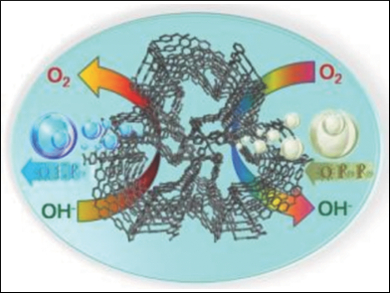Oxygen reduction reactions (ORR) and oxygen evolution reactions (OER) are two important reactions for electrochemical energy conversion and storage technologies, such as metal-air batteries and water electrolysis. Expensive noble metals, e.g. platinum and ruthenium, are commonly used as catalysts for ORR and OER. Metal-organic frameworks (MOFs) could be an alternative to noble-metal electrocatalysts. Their atomically dispersed metal atoms can act as catalytic active sites.
Hegen Zheng, Nanjing University, China, Liming Dai, Case Western Reserve University, Cleveland, OH, USA, and University of New South Wales, Sydney, Australia, and colleagues have developed a MOF-derived material named C-MOF-C2-900 that exhibits bifunctional electrocatalytic activity towards both ORR and OER. The catalyst outperforms commercial Pt/C and RuO2 catalysts. The MOF derivative was prepared via carbonization of a pair of enantiotropic Co-MOFs, yielding homogeneously distributed cobalt nanoparticles encapsulated by partially graphitized carbon rings. C-MOF-C2-900 has a hierarchical rod-like structure which favors the transfer of electrons during ORR and OER.
The team fabricated a Zn-air battery based on C-MOF-C2-900 for the ORR as well as a rechargeable Zn-air battery based on C-MOF-C2-900 as an ORR and OER bifunctional catalyst. Both batteries outperformed their counterparts based on a Pt/C air electrode and a Pt/C + RuO2 mixture, respectively. The researchers also built a two-electrode water-splitting system based on a C-MOF-C2-900 electrode for the OER and a Pt/C electrode for the hydrogen evolution reaction. The system has a stable potential of 1.68 V and a gas production rate of 10.1 and 4.9 µL/s for hydrogen and oxygen gas, respectively.
- Novel MOF-Derived Co@N-C Bifunctional Catalysts for Highly Efficient Zn-Air Batteries and Water Splitting,
Mingdao Zhang, Quanbin Dai, Hegen Zheng, Mindong Chen, Liming Dai,
Adv. Mater. 2018.
https://doi.org/10.1002/adma.201705431


